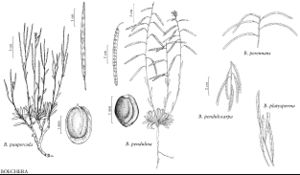Difference between revisions of "Boechera pendulina"
Phytologia 51: 370. 1982.
FNA>Volume Importer |
FNA>Volume Importer |
||
| Line 14: | Line 14: | ||
|name=Arabis demissa var. russeola | |name=Arabis demissa var. russeola | ||
|authority=Rollins | |authority=Rollins | ||
| − | }}{{Treatment/ID/Synonym | + | }} {{Treatment/ID/Synonym |
|name=Arabis diehlii | |name=Arabis diehlii | ||
|authority=M. E. Jones | |authority=M. E. Jones | ||
| − | }}{{Treatment/ID/Synonym | + | }} {{Treatment/ID/Synonym |
|name=Arabis pendulina var. russeola | |name=Arabis pendulina var. russeola | ||
|authority=(Rollins) Rollins | |authority=(Rollins) Rollins | ||
| − | }}{{Treatment/ID/Synonym | + | }} {{Treatment/ID/Synonym |
|name=Arabis setulosa | |name=Arabis setulosa | ||
|authority=(Greene) W. A. Weber | |authority=(Greene) W. A. Weber | ||
| − | }}{{Treatment/ID/Synonym | + | }} {{Treatment/ID/Synonym |
|name=Boechera demissa var. pendulina | |name=Boechera demissa var. pendulina | ||
|authority=(Greene) N. H. Holmgren | |authority=(Greene) N. H. Holmgren | ||
| − | }}{{Treatment/ID/Synonym | + | }} {{Treatment/ID/Synonym |
|name=Boechera demissa var. russeola | |name=Boechera demissa var. russeola | ||
|authority=(Rollins) N. H. Holmgren | |authority=(Rollins) N. H. Holmgren | ||
| − | }}{{Treatment/ID/Synonym | + | }} {{Treatment/ID/Synonym |
|name=Boechera pendulina var. russeola | |name=Boechera pendulina var. russeola | ||
|authority=(Rollins) Dorn | |authority=(Rollins) Dorn | ||
| Line 47: | Line 47: | ||
|elevation=1600-3100 m | |elevation=1600-3100 m | ||
|distribution=Ariz.;Calif.;Colo.;Nev.;Utah;Wyo. | |distribution=Ariz.;Calif.;Colo.;Nev.;Utah;Wyo. | ||
| − | |discussion=<p>Although included in Arabis (Boechera) demissa by some authors (e.g., S. L. Welsh et al. 2003; N. H. Holmgren 2005b), B. pendulina is readily distinguished from that species (see M. D. Windham and I. A. Al-Shehbaz 2006 for detailed comparison). Typical collections are sexual diploids, whereas the type of var. russeola is a triploid apomict; further study is needed to determine if the two are conspecific.</p> | + | |discussion=<p>Although included in <i>Arabis</i> (<i>Boechera</i>) demissa by some authors (e.g., S. L. Welsh et al. 2003; N. H. Holmgren 2005b), <i>B. pendulina</i> is readily distinguished from that species (see M. D. Windham and I. A. Al-Shehbaz 2006 for detailed comparison). Typical collections are sexual diploids, whereas the type of var. russeola is a triploid apomict; further study is needed to determine if the two are conspecific.</p> |
|tables= | |tables= | ||
|references= | |references= | ||
| Line 71: | Line 71: | ||
|publication year=1982 | |publication year=1982 | ||
|special status= | |special status= | ||
| − | |source xml=https://jpend@bitbucket.org/aafc-mbb/fna-data-curation.git/src/ | + | |source xml=https://jpend@bitbucket.org/aafc-mbb/fna-data-curation.git/src/8f726806613d60c220dc4493de13607dd3150896/coarse_grained_fna_xml/V7/V7_564.xml |
|tribe=Brassicaceae tribe Boechereae | |tribe=Brassicaceae tribe Boechereae | ||
|genus=Boechera | |genus=Boechera | ||
Revision as of 17:58, 18 September 2019
Perennials; short- to long-lived; sexual or apomictic; caudex sometimes woody. Stems usually 2–6 per caudex branch, arising from margin of rosette near ground surface, or arising laterally proximal to sterile shoots, 0.6–3(–3.7) dm, sparsely to densely pubescent proximally, trichomes simple, 0.3–0.8 mm, glabrous distally. Basal leaves: blade oblanceolate to obovate, 1.5–6 mm wide, margins usually entire, rarely dentate, ciliate throughout, trichomes (usually simple), 0.4–1 mm, surfaces pubescent, trichomes simple and short- and long-stalked, 2-rayed, 0.3–0.8 mm. Cauline leaves: 2–10(–13), not concealing stem; blade auricles absent or, rarely, to 0.7 mm, surfaces of distalmost leaves glabrous or margins sparsely ciliate. Racemes 4–14-flowered, usually unbranched. Fruiting pedicels divaricate-ascending to horizontal, curved or angled downward, 3–7(–10) mm, usually glabrous, rarely with some simple trichomes. Flowers divaricate-ascending at anthesis; sepals usually sparsely pubescent, rarely glabrous; petals whitish to pale lavender, 4–6 × 1–1.5 mm, glabrous; pollen ellipsoid or spheroid. Fruits widely pendent, not appressed to rachis, not secund, curved to nearly straight, edges parallel, 2.2–4 cm × 1.2–2.1 mm; valves glabrous; ovules 40–70(–90) per ovary; style 0.1–0.3(–0.5) mm. Seeds biseriate, 0.9–1.2 × 0.6–0.9 mm, usually not winged. 2n = 14, 21.
Phenology: Flowering Apr–Jun.
Habitat: Rock outcrops, open gravelly flats and hillsides in sagebrush, pinyon-juniper, mountain mahogany, open conifer forests
Elevation: 1600-3100 m
Distribution

Ariz., Calif., Colo., Nev., Utah, Wyo.
Discussion
Although included in Arabis (Boechera) demissa by some authors (e.g., S. L. Welsh et al. 2003; N. H. Holmgren 2005b), B. pendulina is readily distinguished from that species (see M. D. Windham and I. A. Al-Shehbaz 2006 for detailed comparison). Typical collections are sexual diploids, whereas the type of var. russeola is a triploid apomict; further study is needed to determine if the two are conspecific.
Selected References
None.
